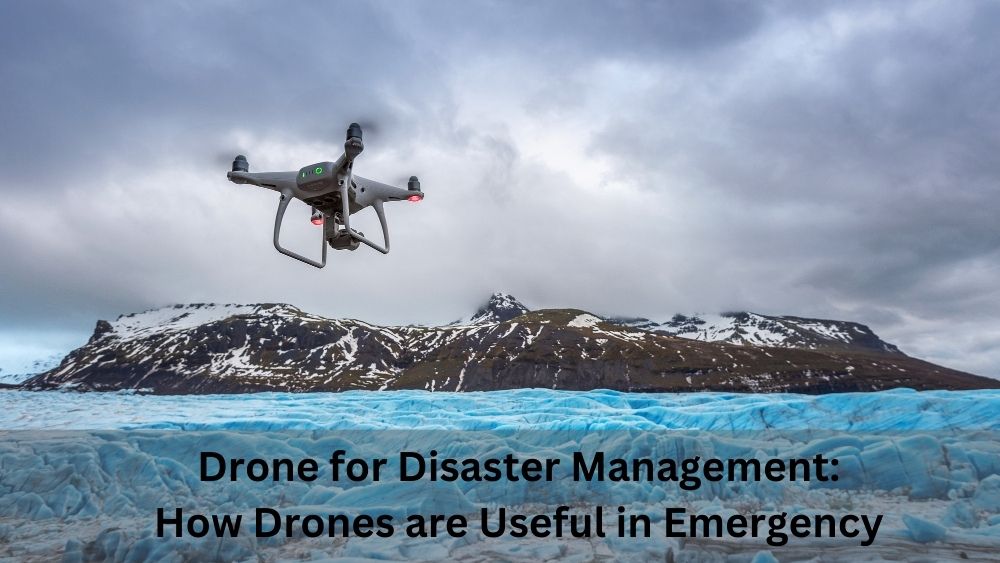Technology has reached people in many ways. Drones also known as “Unmanned Aerial Vehicles” are equipped with an array of useful equipment for taming either natural or man-made disasters. This blog focuses on how drone disaster management is useful during emergencies.
The Role of Drone Disaster Management
A great variety of scenarios have found them useful as time goes by. These airborne marvels are just as strong in their application; from early warning systems to recovery inspection. So, what role are they playing now? Let’s take a detailed look at the role of drones in emergencies.
Drone Disaster Management: A Rapid Response Tool
In the beginning phases of a disaster, time is of the essence. The assessment of damage can be handled by drones carrying high-resolution cameras. The real-time visual data provides first responders with information for making rescue decisions, allocating resources, and evacuating people. The use of drones in disaster response is important because they offer a wide and direct look at the affected areas. They help in ways that help respondents recognize and deal with the risks.
Search and Rescue Missions Enhanced
Dealing with the disaster situation, and saving those who are left becomes a very important aspect. In darkness or heavy smoke, drones with thermal cameras and infrared sensors can detect heat signatures from human or animal life. They can traverse difficult terrains giving rescuers pinpoint locations for fast and focused rescue efforts. It thereby raises the odds of saving one more life.
Remote Sensing for Flood Detection and Forest Fire Monitoring
Drones are most important when it comes to detecting various disasters; these may include floods or forest fires. They fly over the areas affected, taking clear pictures and videos for an update on the disaster. Such graphics aid in devising escape routes. In addition, they monitor the development of the emergency, together with finding places where things are likely to go wrong. On top of this, the specialized sensors can also be mounted on drones. These sensors are mounted to determine both water levels and air quality satisfying the wishes of decision-making authorities.
Environmental Hazards and Chemical Spills
Drones can be equipped with sensors to measure air and water quality on-site in cases of chemical spills or potential environmental hazards. This is why these UAVs are also capable of assisting in laying out the spread of harmful compounds. The approach is proactive in providing safety for the people’s health and the environment. It not only fails to help the environment recover itself but also confines damage to a minimum.
Damage Assessment and Mapping
Drones are used in post-disaster damage. It is the responsibility of drone disaster management to carry out detailed damage assessments. They fly up and take high-resolution aerial images, as well as maps of affected areas. These maps help them calculate how infrastructure has been damaged, thereby supporting the insurance process as well as exercises in rebuilding. A data-driven approach can help simplify the recovery efforts without detracting from the normality returned to people’s lives.
Reduce Threats and be Prepared for Disaster
Drones are also a crucial part of preparing for and mitigating disaster risks. Disasters also allow the intensity of buildings to be assessed. Governments can identify potential dangers and weaknesses, and improve their infrastructure as well as reduce the risks. Those who prepare in advance save lives and prevent future catastrophes by spending less money on the damage that will be done at the time.
Public Perception and Communication
You need to communicate in disasters, and drones are important for this. Drones equipped with loudspeakers or communication may be able to inform the affected population. Aerial photos that could be put on the internet and shared with the public media will allow live updates to be produced. Accordingly, when people have proper information, they will trust you and act as well.
International Cooperation in Disaster Relief
Drones have made this type of international collaboration easy for disaster relief operations. They can also fly with great speed to areas affected by natural disasters where local governments need assistance. Drone disaster response activities are also capable of providing information collected in international organizations that is useful, which facilitates resource allocation and coordination. Nevertheless, a disaster relief global technology integration such as this must be beneficial to the international community and its disaster relief work.
Challenges and Considerations
Even as drones change everything about dealing with natural disasters, there are some challenges and considerations that we should not overlook:
- Regulatory Framework: There are different laws in different countries on using drones for natural disaster control. The procedures for ascertaining that local regulations are met, and permits are issued, are also very complex.
- Privacy Concerns: Insensitivity and invasion of privacy are concerns arising from drones photographing and videotaping individuals with neither their knowledge nor consent. It’s important to reconcile privacy concerns with disaster response.
- Technical limitations: In general, drones can remain airborne for 20 to 30 minutes at most. This is a certain kind of constraint in terms of disaster management. It calls for advanced planning and coordination to optimize the use of these assets in times of disaster.
- Data Management: Large quantities of data generated by drones require storage, analysis, and dissemination protocols. Data security and privacy must be maintained throughout the process.
- Cost: The start-up is large for delivery systems and maintenance. Public servants and corporate buyers of such equipment will have to weigh these costs against their potential benefits.
Conclusion:
We hope now you know why drone disaster management is so essential during emergency scenarios. From our eve, we tried to cover every major narrative so that you know the perks of it completely! To avail of these services, you can contact one of the leading companies, Canada Sky Drones.

